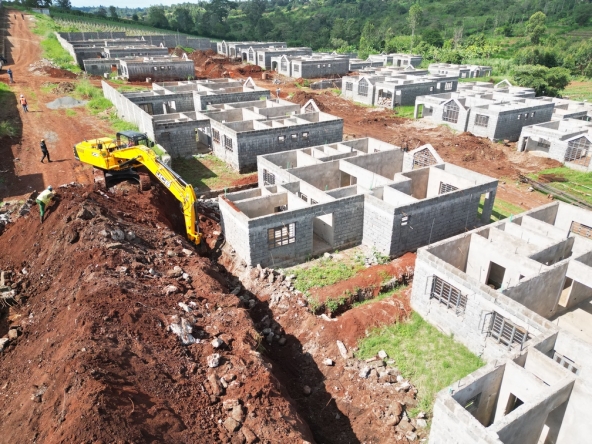Kenya’s affordable housing dream may be edging closer to reality after years of slow progress, stalled projects, and growing public skepticism. A new multi-billion-shilling injection — backed by the World Bank and commercial lenders — could begin to shift the country’s stubborn homeownership landscape, if the rollout stays disciplined and transparent.
For now, the spotlight is firmly back on a programme many had started to give up on.
A Housing Crisis Hiding in Plain Sight
The numbers often quoted — a 61% national homeownership rate — rarely tell the whole story. That figure is heavily inflated by rural inheritance, not urban purchase.
In Kenya’s towns and cities, where rent rises faster than salaries, the real picture is far tougher:
only 21.3% of urban residents own homes, while millions belong to a perpetual renter class, constantly priced out by both the market and the mortgage system meant to support them.
Meanwhile, Kenya’s housing deficit grows by 200,000 units every year, swallowing up any slow gains made.
And despite heavy marketing around the Affordable Housing Programme, traction has been modest:
| Key Indicator | Current Number |
|---|---|
| Registered on Boma Yangu | 547,000 adults (≈2% of population) |
| Consistent savers | 52,000 people |
| Annual housing deficit | 200,000 units |
| Urban homeownership rate | 21.3% |
| Funding secured | $1.35B (Sh167.9B) |
The low number of consistent savers — one in ten — speaks not only to tight budgets, but to public uncertainty. Many Kenyans want a home but are simply not convinced the system will deliver it.
A New Wave of Funding — And What It Could Change

The new housing package totals $1.35 billion (Sh167.9 billion), structured as:
- $375 million (Sh48.4 billion) concessional loan from the World Bank
- $900 million (Sh116.3 billion) to be raised from commercial lenders via a sustainability-linked sovereign loan
A significant portion is expected to flow through the Kenya Mortgage Refinancing Company (KMRC), the state-backed institution that refinances mortgages so banks can issue loans at more predictable, lower rates.
If executed effectively, this could:
- Reduce mortgage interest rates to more manageable levels
- Lengthen repayment periods
- Encourage banks to create friendlier, lower-deposit mortgage products
- Bring thousands of “near-miss” buyers closer to homeownership
For years, mortgages in Kenya have felt like a luxury product. This funding may help push them closer to the middle class.
What This Could Mean for the Kenyan Buyer
The biggest question for ordinary Kenyans is simple: Will this actually make mortgages affordable?
Potentially, yes — but only if the funding is deployed with discipline.
KMRC’s role could allow banks to issue:
- Lower interest mortgages that don’t choke a salary
- Longer repayment horizons that ease monthly pressure
- Smaller deposit requirements, making the first step less intimidating
For first-time buyers and young families who have hovered on the edges of homeownership, this could be the moment when renting stops being the only realistic option.
But these benefits depend entirely on how quickly — and how transparently — the money moves from institutions to actual buyers.
What Developers Might Do Next

Financing alone won’t build houses. Developers must decide whether to pivot from high-margin luxury projects to lower-cost units that align with the new funding.
Here’s what could unfold:
- If developers respond positively: more units break ground, prices stabilize, and the market begins to reflect real incomes.
- If developers hesitate: supply remains thin, and affordability gains evaporate before reaching buyers.
- If the rollout is rushed: poor quality, delayed titles, or abandoned projects could re-ignite public mistrust.
The next 18 months will be revealing. The first mortgage products issued under this funding, the first units completed, and the first families moving in — these will determine whether this programme marks a genuine turning point or merely another well-funded attempt with limited impact.
Read Also: Makongeni Demolitions: Legal, Social Firestorm as Eviction Deadline Looms
A Spark With Potential — Not a Miracle
Kenya’s new housing funds carry enormous promise, but not a guaranteed solution. They can shift the market, unlock mortgage access, and make homeownership attainable for thousands. But money alone cannot fix structural inefficiencies, supply gaps, inflated land prices, or decades of public skepticism.
Execution — fair, timely, transparent execution — will decide whether this becomes a chapter of progress or just another statistic.
For Kenyans watching from the sidelines, the advice is practical:
- Save if you can
- Track the early projects and mortgage offers
- Watch how quickly units are delivered and to whom
Not the headlines, not the promises — the homes people actually move into will tell the real story.
This may not be a revolution yet, but it could be the moment the story starts to change.




